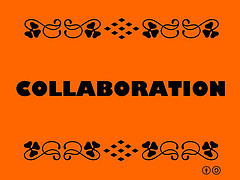|
|
|
Archive for the 'Change' Category
Thursday, June 2nd, 2016
 The entrepreneurial mantra that weaves through every startup vision and recruitment effort focuses on how X product/service will change the world. The entrepreneurial mantra that weaves through every startup vision and recruitment effort focuses on how X product/service will change the world.
This particular passion applies whether it’s a cure for cancer, a big data application, a new messaging app, social network or dating app.
How does one truly change the world?
Or is it a phrase with no real meaning?
Even if one does change it does the change make the world better?
Better by what yardstick and whose standards?
Change isn’t always a positive.
What is your responsibility if you do change it?
In his graduation speech at USC, Larry Ellison said, “You will change the world and the world will change you.”
For better or worse, change is the only true constant.
Flickr image credit: Inspiyr.com
Posted in Change, Entrepreneurs | 2 Comments »
Wednesday, September 30th, 2015

No matter your age healthcare is/should be a serious concern.
If not for yourself then for your parents and others you care about.
And not just a new app that delivers services a different way, no matter how good.
What needs to change is the culture of not only insurance companies, but medical service providers (doctors, labs, testing, hospitals, etc.), other various and sundry vendors within the ecosystem, not to mention the government in the form of Medicare and Medicaid.
When you look at the deeply entrenched interests on that list the possibility of anything actually happening in the near-term seems remote, if at all.
Not even the proverbial 500 pound gorilla, think Google or Facebook, has the clout to even dent that crowd.
But what about Aetna Insurance under CEO Mark Bertolini, a 1000 pound gorilla and long-time global player in healthcare that has the clout, since it insures two thirds of the Fortune 100 and a great number of the 500?
…Bertolini called the sector “too bloated and accountable to no one.” The system — which will cost US$4.6 trillion, or 20 percent of U.S. GDP, by 2020 — “charges patients and rewards care providers on services delivered, not patient outcomes,”…
Aetna is taking a three prong approach that includes, paying for positive outcomes, as opposed to fees for services; changing corporate health offerings in order to tap into positive consumer behavior and eating its own dog food — as every good startup does.
The big question is whether Aetna will walk its talk.
Based on the comments it’s questionable.
Flickr image credit: Aetna
Posted in Change, Culture | No Comments »
Wednesday, September 23rd, 2015

According to Kentaro Toyama, the W.K. Kellogg Associate Professor of Community Information at the University of Michigan School of Information and self-described “recovering technoholic,” technology isn’t the panacea it’s cracked up to be.
“Technology works best in organizations that are run well to begin with. (…) The technology industry itself has perpetuated the idea that technology will solve the world’s problems. (…) Everyone wants to believe the work they do is good for society. But a lot of people in the industry have drunk a little too much of their own marketing Kool-Aid.”
What is often ignored is that people are a necessary ingredient for the Kool-Aid to actually work.
The tech eco-system forgets a lesson driven home by Bill Gates in the 1995 book The Road Ahead.
“The first rule of any technology used in a business is that automation applied to an efficient operation will magnify the efficiency. The second is that automation applied to an inefficient operation will magnify the inefficiency.”
Aetna Insurance found this out when they first equipped their claims processors with their own terminals connected to the mainframe (before the advent of personal computers).
The effort was considered ground-breaking and was touted as a way to streamline the claims process.
It failed miserably, because the process itself wasn’t redesigned.
In short, claims had multiple steps with approval required at each. Because the process stayed the same, i.e., claims stalled in electronic form when someone in the approval process was on jury duty or out sick just as they did in the paper version.
Once people redesigned the process the desired efficiencies were reaped well beyond expectations.
Technology is a tool, not a silver bullet; the only real silver bullets are found within the human mind.
Ultimately the right thing is for us to find the optimal use of technology — not to eliminate it, but also not to assume that it can replace human skills.
Flickr image credit: Jason Rogers
Posted in Change, Culture | 2 Comments »
Tuesday, September 15th, 2015

Steve Blank wrote a great post about changing culture in larger organizations. It’s a must-read for anyone in business, government or non-profit who is looking to juice innovation in their organization.
Blank agrees that there are four components to culture.
Two McKinsey consultants, Terry Deal and Arthur Kennedy wrote a book called Corporate Cultures: The Rites and Rituals of Corporate Life. In it they pointed that every company has a culture – and that culture was shorthand for “the way we do things at our company.” Company culture has four essential ingredients:
- Values/beliefs – set the philosophy for everything a company does, essentially what it stands for
- Stories/myths – stories are about how founders/employees get over obstacles, win new orders…
- Heroes – what gets rewarded and celebrated, how do you become a hero in the organization?
- Rituals – what and how does a company celebrate?
He goes on to explain what needs to be done for “innovation to happen by design not by exception.”
While I agree with everything he says, I believe he left out a most critical component.
In reality it should be a subset of values/beliefs, but it is rarely thought about by bosses — they either do it or do the opposite automatically.
It can be summed up in four words, don’t kill the messenger—Pete Carroll, coach of the Seattle Seahawks, is a master of this mindset.
To be truly innovative means trying new stuff and a part of trying new stuff is accepting that it won’t always work.
Corporate culture in general and many bosses individually can’t seem to wrap their minds around the idea that some things will fail — it’s the dark side of the ‘but me mindset’ at work.
What they, and anybody setting out to change culture and encourage innovation, need to understand is that it only takes killing the messenger, i.e., responding negatively to the person who brings bad news, once to negate whatever progress had been made and put the effort back to square one.
Flickr image credit: Eirik Newth
Posted in Change, Culture, Ducks In A Row | 1 Comment »
Tuesday, August 25th, 2015

Different generations, but bosses are asking the same questions.
How do I implement cultural and other intangible changes and, more importantly, encourage (or, if necessary, coerce) their adoption?
I responded nine years ago and the answer hasn’t really changed.
The most successful method is as simple as one, two, three.
- Carefully define, in a quantifiable manner, what you want done (not “increase retention,” but “reduce turnover by X%”).
- Include these well quantified goals in the managers’ annual objectives.
- Make it clear to your managers that they will be evaluated on these goals and that the evaluation will impact their annual reviews and compensation.
Vested self-interest will do the rest.
Flickr image credit: Martin Cooper
Posted in Change, Culture | No Comments »
Monday, June 15th, 2015
 First it was Uber drivers, members of the so-called 1099 economy, who sued Uber. First it was Uber drivers, members of the so-called 1099 economy, who sued Uber.
Next, the general public woke up to tech’s rapacious abuse of their privacy and personal information.
And last week nearly half of shareholders voted against the executive compensation plan of a company whose stock is near its all-time high.
According to an SEC document filed Tuesday, nearly 47% of the total shareholders voted against Salesforce’s executive compensation packages at its annual shareholders meeting…
Maybe, just maybe, corporate America has finally gone too far and we’re ready to fight back.
Flickr image credit: Annelid
Posted in Change, Compensation | No Comments »
Wednesday, May 13th, 2015

It’s impressive when a market set to double from roughly $4+ billion to $8+ billion by 2019 doesn’t really solve the problem it claims to solve.
Huh?
The market is collaboration software and, based on new research, it only works for half the problem.
Unfortunately, it turns out that inducing more collaboration may hinder the most important part of problem-solving: actually solving the problem. While connecting employees does increase the ability to gather facts during the early stages of tackling a problem, it also inhibits the ability to analyze those facts and find a solution.
The 21st Century approach that’s been pushed by academics and the collaboration industry has been supported only by research done separately on the two halves.
Solving any problem requires two distinct steps,
- Collecting data
- Analyzing and using the data.
The first responds well to collaboration; a variety of people with different experiences and world-views are less likely to homogenize their information-gathering.
… the most-clustered groups gathered 5 percent more information than the least-clustered groups…
However, the gain didn’t carry over to a solution.
Clustering also seemed to inhibit the breadth and number of answers that the players proposed. The least-connected networks came up with 17.5 percent more theories and solutions than did the most-connected networks.
17.5% is a significant number — especially when it’s your organization.
Collaboration is a marvelous tool, but it’s not a silver bullet.
As with most good tools it needs to be used where and when it works.
Flickr image credit: Ron Mader
Posted in Change, Culture, Motivation | No Comments »
Tuesday, April 28th, 2015

Considering all the hand-wringing and diverse efforts to attract women to tech, it turns out that it’s relatively simple.
Lina Nilsson is a Ph.D. in biomedical engineering and director of innovation at the Blum Center for Developing Economies at UC Berkeley, noticed a quaint factoid.
…if the content of the work itself is made more societally meaningful, women will enroll in droves. That applies not only to computer engineering but also to more traditional, equally male-dominated fields like mechanical and chemical engineering.
This held true at dozens of universities, such as D-Lab at MIT, Arizona State University, University of Minnesota, Pennsylvania State University and Santa Clara University.
And it’s important to recognize that the primary, or even secondary, intent was not to attract women, but to solve problems.
None of the programs, clubs and classes were designed with the main goal of appealing to female engineers, and perhaps this is exactly why they are drawing us in. At the core of each of the programs is a focus on engineering that is cutting edge, with an explicit social context and mission.
The problem, of course, is that most existing companies and current startups are focused on money, while “women seem to be drawn to engineering projects that attempt to achieve societal good.”
Higher purpose vs. greed says it all.
Image credit: Kurt Bauschardt
Posted in Change, Ducks In A Row | No Comments »
Monday, April 27th, 2015

Having trouble getting people to do things differently or do something new?
According to Henry Thoreau, “Things don’t change, people do.”
Over the years, I’ve watched managers and companies try to change the outcome without changing the input.
They’ve talked/explained/begged/pleaded/threatened, but nothing changes.
They are suffering from Einstein’s version of insanity.
Doing the same thing over and over again and expecting different results.
If change is the goal, it’s best to start with yourself.
“To change what they do, change how you think.”
You need to change because the way you think, what you think, how you think, and what you believe — in other words your MAP — dictates the authenticity of what you do and the responses you get.
No matter what great ideas you read, hear or talk, no matter what great leader you try and channel, you will always walk your own MAP.
Image credit: Newtown graffiti
Posted in Change, Personal Growth | No Comments »
Wednesday, January 14th, 2015

How about that. Target, the White House, CIA, FBI and a host of other companies have been hacked and people shrug it off.
The Sony hack was different — a political show of arms.
Last week I commented on the FTC chairwoman Edith Ramirez’s focus on security at CES.
Seems she’s not the only one.
According to a survey by Piper Jaffray, security was ranked as the top spending priority for CIOs this year, with a whopping 75% of the respondents saying they would increase spending in 2015.
That’s nearly 20% higher than last year.
It’s about time — if they follow through.
And it looks like they might, since the venture crowd has scented money.
Piper Jaffray’s survey asked only 112 CIOs across eight different industries, so the results should be taken with a grain of salt. Still, security seems to be a huge concern for everyone in tech, as some of the top venture capitalists in Silicon Valley also picked it as one of their biggest investment areas this year.
That concern is also being driven partly by users waking up to the fact that while companies are happy to take their money they haven’t given much of a damn about keeping their online selves safe, i.e., their information secure.
And that is turning up the heat on the privacy issue as those same companies splice, dice and sell personally identifiable information to enhance their own bottom line.
The dangerous, even lethal, ramifications of hacking are obvious.
Thanks to the hacks of 2014, culminating with Sony, tech’s laissez-faire, “it’s not our problem” attitude towards these dangers seems to be changing.
One can only hope that it changes faster than connectivity grows.
Image credit: markus jakobs
Posted in Change, Culture | No Comments »
|
 Subscribe to
Subscribe to
MAPping Company Success
About Miki 
Clarify your exec summary, website, etc.
Have a quick question or just want to chat? Feel free to write or call me at 360.335.8054
The 12 Ingredients of a Fillable Req
CheatSheet for InterviewERS
CheatSheet for InterviewEEs™
Give your mind a rest. Here are 4 quick ways to get rid of kinks, break a logjam or juice your creativity!
Creative mousing
Bubblewrap!
Animal innovation
Brain teaser
The latest disaster is here at home; donate to the East Coast recovery efforts now!
Text REDCROSS to 90999 to make a $10 donation or call 00.733.2767. $10 really really does make a difference and you'll never miss it.
And always donate what you can whenever you can
The following accept cash and in-kind donations: Doctors Without Borders, UNICEF, Red Cross, World Food Program, Save the Children
*/
?>About Miki
About KG
Clarify your exec summary, website, marketing collateral, etc.
Have a question or just want to chat @ no cost? Feel free to write
Download useful assistance now.
Entrepreneurs face difficulties that are hard for most people to imagine, let alone understand. You can find anonymous help and connections that do understand at 7 cups of tea.
Crises never end.
$10 really does make a difference and you’ll never miss it,
while $10 a month has exponential power.
Always donate what you can whenever you can.
The following accept cash and in-kind donations:
|
 The entrepreneurial mantra that weaves through every startup vision and recruitment effort focuses on how X product/service will change the world.
The entrepreneurial mantra that weaves through every startup vision and recruitment effort focuses on how X product/service will change the world.







 First it was Uber drivers, members of the so-called 1099 economy, who
First it was Uber drivers, members of the so-called 1099 economy, who 




